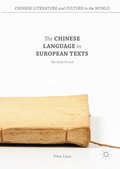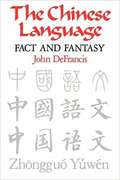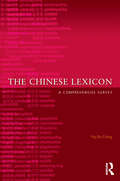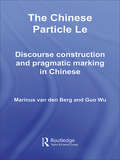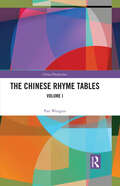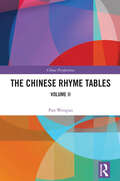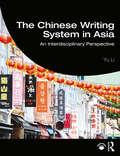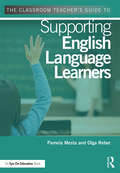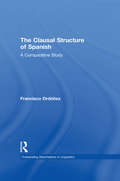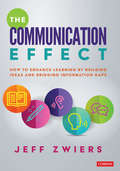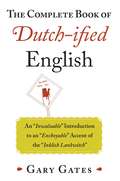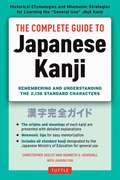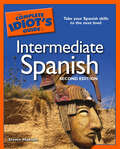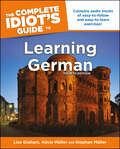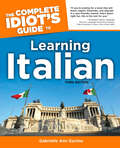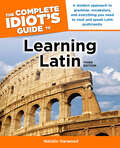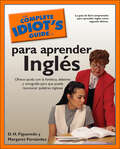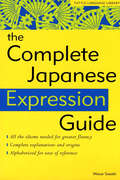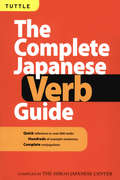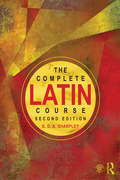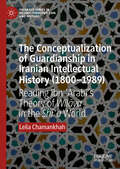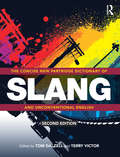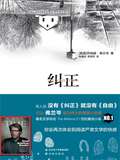- Table View
- List View
The Chinese Language in European Texts
by Dinu LucaThis detailed, chronological study investigates the rise of the European fascination with the Chinese language up to 1615. By meticulously investigating a wide range of primary sources, Dinu Luca identifies a rhetorical continuum uniting the land of the Seres, Cathay, and China in a tropology of silence, vision, and writing. Tracing the contours of this tropology, The Chinese Language in European Texts: The Early Period offers close readings of language-related contexts in works by classical authors, medieval travelers, and Renaissance cosmographers, as well as various merchants, wanderers, and missionaries, both notable and lesser-known. What emerges is a clear and comprehensive understanding of early European ideas about the Chinese language and writing system.
The Chinese Lexicon: A Comprehensive Survey
by Yip Po-ChingThe Chinese Lexicon is a detailed study of the words and word combinations used in modern Chinese. Yip Po-Ching defines the general properties of a language's lexicon, or vocabulary, prior to a thorough discussion of the organizational features of the Chinese lexicon. Comparisons are made between Chinese and English, highlighting the similarities and differences between the two lexicons. This fascinating work examines the relationships between word and meanings, and demonstrates the ability of language to combine continuity and change. It surpasses the scope of a dictionary and reveals the systematic nature of vocabulary. Features include: a wealth of language examples clear comparisons between Chinese and English Chinese characters and pinyin romanization throughout a comprehensive index. The Chinese Lexicon surpasses the scope of a dictionary and reveals the systematic nature of vocabulary. It will prove an invaluable resource for all students and teachers of Chinese.
The Chinese Particle Le: Discourse Construction and Pragmatic Marking in Chinese (Routledge Studies in Asian Linguistics)
by M.E. van den Berg G. WuEver since the start of Chinese linguistic studies, the description of the Chinese particle LE has remained elusive. The classification has evolved from a listing of sentences and the discussion of contrastive pairs to a more context and discourse-oriented analysis. The development in recent years of inferential models and situation semantics has opened the way for a renewed study of the use of the Chinese particle LE. This book discusses the Chinese data from a 'mental space' perspective and finally reveals the role so-called Chinese 'sentence LE' plays in the construction and maintenance of discourse.
The Chinese Rhyme Tables: Volume I (China Perspectives)
by Pan WenguoAs the first volume of a two-volume set that studies Chinese rhyme tables, this book focuses on their emergence, development, structure, and patterns. Rhyme tables are tabulated tool constituted by phonological properties, which helps indicate the pronunciation of sinograms or Chinese characters, marking a precise and systematic account of the Chinese phonological system. This volume first discusses the emergence of the model and factors that determined its formation and evolution, including the Chinese tradition of the rhyme dictionary and the introduction of Buddhist scripts. The second part analyzes the structure and arrangement patterns of rhyme tables in detail, giving insights into the nature of “division” (deng): the classification and differentiation of speech sounds, of vital significance in the reconstruction of middle Chinese. The author argues that deng has nothing to do with vowel aperture or other phonetic features but is a natural result of rhyme table arrangement. He also reexamines the principles for irregular cases (menfa rules) and categorizes the 20 rules into three types.The book will appeal to scholars and student studying linguistics, Chinese phonology, and Sinology.
The Chinese Rhyme Tables: Volume II (China Perspectives)
by Pan WenguoAs the second volume of a two-volume set that studies the Chinese rhyme tables, this book seeks to reconstruct the ancient rhyme tables based on the extant materials and findings. A rhyme table is a tabulated tool constituted by phonological properties, which helps indicate the pronunciation of sinograms or Chinese characters, marking an accurate and systematic account of the Chinese phonological system. The book first explores the relationship and identifies the prototype of the extant rhyme tables. Then the principles and methods for collating and rebuilding the ancient rhyme table are introduced. It then looks at the general layout, including tables, table order, shè, zhuǎn, rhyme heading, rhyme order, light and heavy articulations, rounded and unrounded articulations, and initials. The final chapter presents the reconstructed rhyme tables with detailed annotations and add-on indexes. The book will appeal to scholars and students studying Sinology, Chinese linguistics, and especially Chinese phonology.
The Chinese Writing System in Asia: An Interdisciplinary Perspective
by Yu LiThe Chinese Writing System in Asia: An Interdisciplinary Perspective integrates a diverse range of disciplinary approaches in examining how the Chinese script represents and actively shapes personal and social identities in and beyond Asia. It is an ideal read for students and scholars interested in a broad and culturally rich introduction to research on the Chinese writing system. It can also serve as the main text of an undergraduate course on the subject. Key features of this volume include: Insights from studies of the Chinese writing system in linguistics, script reform and technology, gender, identity, literature, and the visual arts; Examples embedded in inquiries of the cultural history and contemporary society of Asia; Rigorous yet accessible discussions of complex concepts and phenomena that assume no prior knowledge of Asian languages or linguistics; Supplementary multimedia materials and resources, including instructional support, available online.
The Classroom Teacher's Guide to Supporting English Language Learners
by Pamela Mesta Olga ReberThis book answers your key questions about educating English Language Learners (ELLs) and offers detailed guidance and concrete applications for your classroom. Designed as a one-stop-shop for classroom teachers of all grade levels and content areas, this book is chock full of essential information, delivered in a practical, concise format. In each chapter, you will find checklists, instructional strategies, tables, tools and ideas for next steps. The resources and examples provided are easy to implement and can be used the next day in your teaching. Topics addressed include: Getting to know your ELLs Considering how culture, language and academic background impact learning Bridging the home/school connection Pairing content and language objectives Gauging learner progress Collaborating with ELL staff Much more!
The Clausal Structure of Spanish: A Comparative Study (Outstanding Dissertations in Linguistics)
by Francisco OrdonezFirst Published in 2000. Routledge is an imprint of Taylor & Francis, an informa company.
The Communication Effect: How to Enhance Learning by Building Ideas and Bridging Information Gaps
by Jeff ZwiersThe &“communication effect&” is what happens when we saturate our classrooms with authentic communication, which occurs when students use language to build up ideas and do meaningful things. For starters, authentic communication deepens and increases language development, learning of content concepts and skills, rigor and engagement, empathy and understanding of others&’ perspectives, agency and ownership of core ideas across disciplines, and social and emotional skills for building strong relationships. And these are just the starters. With The Communication Effect, Dr. Jeff Zwiers challenges teachers in Grades 3 and up to focus less on breadth and more on depth by grounding instruction and assessment in authentic (rather than pseudo-) communication. This book provides: Ideas for cultivating classroom cultures in which authentic communication thrives Clear descriptions and examples of the three features of authentic communication: 1. building up key ideas (claims and concepts); 2. clarifying terms and supporting ideas; and 3. creating and filling information gaps Over 175 suggestions for using the three features of authentic communication to enhance twenty commonly used instructional activities across disciplines Additional examples of not-so-commonly-used activities that embody the three features Suggestions for improving four different types of teacher creativity needed to design effective lessons, activities, and assessments that maximize authentic communication Our students deserve to get the most out of each minute of each lesson. Authentic communication can help. As you read The Communication Effect and apply its ideas, you will see how much better equipped and inspired your students are to grow into the amazing and gifted people that they were meant to become.
The Communication Effect: How to Enhance Learning by Building Ideas and Bridging Information Gaps
by Jeff ZwiersThe &“communication effect&” is what happens when we saturate our classrooms with authentic communication, which occurs when students use language to build up ideas and do meaningful things. For starters, authentic communication deepens and increases language development, learning of content concepts and skills, rigor and engagement, empathy and understanding of others&’ perspectives, agency and ownership of core ideas across disciplines, and social and emotional skills for building strong relationships. And these are just the starters. With The Communication Effect, Dr. Jeff Zwiers challenges teachers in Grades 3 and up to focus less on breadth and more on depth by grounding instruction and assessment in authentic (rather than pseudo-) communication. This book provides: Ideas for cultivating classroom cultures in which authentic communication thrives Clear descriptions and examples of the three features of authentic communication: 1. building up key ideas (claims and concepts); 2. clarifying terms and supporting ideas; and 3. creating and filling information gaps Over 175 suggestions for using the three features of authentic communication to enhance twenty commonly used instructional activities across disciplines Additional examples of not-so-commonly-used activities that embody the three features Suggestions for improving four different types of teacher creativity needed to design effective lessons, activities, and assessments that maximize authentic communication Our students deserve to get the most out of each minute of each lesson. Authentic communication can help. As you read The Communication Effect and apply its ideas, you will see how much better equipped and inspired your students are to grow into the amazing and gifted people that they were meant to become.
The Complete Book of Dutch-ified English: An “Inwaluable” Introduction to an “Enchoyable” Accent of the “Inklish Lankwitch”
by Gary GatesHere is a book for anyone tired of speaking flat, colorless, homogenized English. Pennsylvania Dutchman Gary Gates provides a glossary, read-aloud section, songs, recipes, and more in this delightful, ?inwaluable” introduction to Dutch-ified English.Learn the meaning of ?rutch” and ?spritz,” what a ?clod” and a ?crotch” are, how to pronounce and make ?Cussin Rache’s Snitz and Knepp,” and what has happened to food when it’s ?all.” Spice up your vocabulary with delightful words and phrases, such as:? Grex: To complain, moan. ?Ah, quit your grexing, you have a vonderful life.”? Face: Belief, religious conwiction. ?Praise be! Rebecca has found her face in the Lord again!”? Gruntbecky: An expression of hard going. ?Gruntbecky! It’s difficult to run in this hot sun.”? Nix nootz: A devilish, mischievous person. ?Our daughter is a little nix nootz.”? Rupdawn: A massage. ?A good rupdawn will take the ache away.”Tired of trying to conform to traditional speech patterns, Gary offers a warm and funny celebration of the unique Dutch culture in America.
The Complete Guide to Japanese Kanji: Remembering and Understanding the 2,136 Standard Characters
by Kenneth G. Henshall Jiageng Fan Christopher SeelyLearn over 2,000 Japanese Kanji characters with this user-friendly Japanese language-learning book.This unique Kanji study guide provides a comprehensive introduction to all the Kanji characters on the Japanese Ministry of Education's official Joyo ("General Use") list-providing detailed notes on the historical development of each character as well as all information needed by students to read and write them. As fascinating as it is useful, this is the book every Japanese language learners keeps on his or her desk and visits over and over.This Kanji book includes: Clear, large-sized entries All of the General Use Joyo Kanji Characters Japanese readings and English meanings stroke-count stroke order usage examples mnemonic hints for easy memorization The components which make up each character are detailed and the Kanji are graded in difficulty according to Ministry of Education guidelines, allowing students to prioritize the order in which the Kanji are learned and track their progress. This book is essential to anyone who is planning to take the official Japanese Language Proficiency Test (JLPT) and will appeal to beginning students as well as those who wish to attain higher-level mastery of the Japanese language. It is the only book that also provides historical and etymological information about the Japanese Kanji.This latest edition has been updated to include all of the 2,136 Kanji on the expanded Joyo list issued by the Japanese government in 2010. Many entries have been revised to include the most recent research on character etymologies.
The Complete Guide to Japanese Kanji: Remembering and Understanding the 2,136 Standard Characters
by Kenneth G. Henshall Jiageng Fan Christopher SeelyLearn over 2,000 Japanese Kanji characters with this user-friendly Japanese language-learning book.This unique Kanji study guide provides a comprehensive introduction to all the Kanji characters on the Japanese Ministry of Education's official Joyo ("General Use") list-providing detailed notes on the historical development of each character as well as all information needed by students to read and write them. As fascinating as it is useful, this is the book every Japanese language learners keeps on his or her desk and visits over and over.This Kanji book includes: Clear, large-sized entries All of the General Use Joyo Kanji Characters Japanese readings and English meanings stroke-count stroke order usage examples mnemonic hints for easy memorization The components which make up each character are detailed and the Kanji are graded in difficulty according to Ministry of Education guidelines, allowing students to prioritize the order in which the Kanji are learned and track their progress. This book is essential to anyone who is planning to take the official Japanese Language Proficiency Test (JLPT) and will appeal to beginning students as well as those who wish to attain higher-level mastery of the Japanese language. It is the only book that also provides historical and etymological information about the Japanese Kanji.This latest edition has been updated to include all of the 2,136 Kanji on the expanded Joyo list issued by the Japanese government in 2010. Many entries have been revised to include the most recent research on character etymologies.
The Complete Idiot's Guide to Intermediate Spanish, 2nd Edition: Take Your Spanish Skills to the Next Level
by Steven HawsonThis revised edition offers expanded coverage of grammar and vocabulary, as well as idiomatic usage, irregular verbs, and conversational elements that will help readers improve their language skills in a variety of situations. In addition, a new workbook section specially designed to help readers practice and retain information has been included.• Includes a comprehensive review of beginning Spanish, plus simple strategies for memorizing cases, endings, and vocabulary• Features an easy-to-understand guide to Spanish idioms• Covers business and medical Spanish• Techniques for mastering vocabulary and grammar• New exercises and answers throughout
The Complete Idiot's Guide to Learning German, 4E
by Lisa Graham Alicia Muller Stephan MullerThis comprehensive guide to mastering the German language presents often difficult-to-master information, such as verb tenses, in the approachable Complete Idiot's Guide® format. Readers will discover useful travel-themed chapters, dealing with everything from shopping, renting cars, and making a phone call, to visiting a doctor, going to the post office, and banking. With information on the essentials of German grammar, vocabulary, pronunciation, and conversation, this new edition also includes a supplemental CD with nearly an hour of listen-and-learn exercises that can be used either with or without the book.
The Complete Idiot's Guide to Learning Italian, 3rd Edition
by Gabrielle EuvinoLearn the language of la dolce vita!For anyone who wants to learn and enjoy the most expressive and romantic of languages, the third edition of The Complete Idiot&’s Guide® to Learning Italian is the first choice for a whole new generation of enthusiastic students of Italian. This updated edition includes two new quick references on verbs, grammar, and sentence structure; two new appendixes on Italian synonyms and popular idiomatic phrases; and updated business and money sections. • First two editions have sold extraordinarily well • Italian is the fourth most popular language in the United States
The Complete Idiot's Guide to Learning Latin, 3rd Edition: A Modern Approach to Grammar, Vocabulary, and Everything You Need to Read and Sp
by Natalie HarwoodAn updated guide to the language of the Roman Empire. Whether interested in learning Latin or just seeking a deeper understanding of English, readers will find a fun alternative to the standard dusty tomes usually associated with Latin. Included in this revised edition are updated vocabulary lists relevant to today&’s world, expanded pronunciation guides, Latin–to–English and English–to–Latin translations, and a workbook of exercises, reading passages, and tools for greater comprehension of the language. • In 2002, the number of high school students taking Latin tests for college credit had risen 95% since 1993 • According to CNN, educators are increasingly turning toward Latin to improve student performance in reading, math, and science • Perfect reference tool for law school, medical school, music school, and other graduate school students faced with getting through a Latin course as a requirement
The Complete Idiot's Guide to Para Aprender Ingles
by D.H. Figueredo Margaret FernandezMillions of Spanish-speaking immigrants enroll in ESL (English as a Second Language) classes every year. This curriculum-based guide offers practical examples, exercises, and quizzes to quickly and effectively bolster English skills.
The Complete Japanese Expression Guide
by Mizue SasakiA companion volume to The Complete Japanese Verb Guide andThe Complete Japanese Adjective Guide, with over 600 idioms.The Complete Japanese Expression Guide enables students to speak and understand idiomatic Japanese with the ease and fluency of a native speaker. For the first time ever, over 600 of the most commonly used idiomatic expressions in the Japanese language have been brought together and alphabetized in a single, convenient volume. No longer will the student have to rely on stuffy academic-sounding phrases and expressions. Mizue Sasaki has successfully taken stilted formality out of Japanese, and made natural, idiomatic communication readily possible. This handy volume not only introduces essential idioms, but also provides easy-to-understand translations and numerous example sentences to show how the expressions should be used. Studying colloquial Japanese doesn't have to be hitori-zumo, a futile effort (page 94). With The Complete Japanese Expression Guide, fluency is guaranteed.
The Complete Japanese Verb Guide
by Hiroo Japanese CenterThe Complete Japanese Verb Guide is a handy, easy-to-use guide to one of the building blocks of language learning—verbs. To effectively learn Japanese, a strong knowledge of Japanese grammar and vocabulary is needed. This book will come to the rescue as it shows learners how to conjugate the 600 most common Japanese verbs quickly, and with very little effort. This is the only guide to list all verb forms in both Japanese script and romanized form, while giving an accurate English translation for each conjugated form, making this book far more comprehensive than any other book on the subject. Compiled by Japanese language experts at The Hiro Japanese Center, more than 30 different verbal forms are given for each verb including all forms used in contemporary spoken, written, formal and conversational Japanese—making this the ideal reference when reading any sort of Japanese printed materials including manga, newspapers, magazines and books. The Complete Japanese Verb Guide places an expert resource at your fingertips, giving you the information you need to speak, read, and write Japanese sentences correctly. Key features of this book are: Includes all the most useful verbs and Kanji (logographic Chinese characters) in Japanese, including less common ones. A wealth of example sentences are given to demonstrate correct verb usage. Over 30 forms are given for each verb including polite or formal, plain, negative, potential, conditional, passive, causative, and many more. Both Kana, Japanese script, and romanized forms are given for each entry. An ideal study guide for the standard Advanced Placement college test and the Japanese Language Proficiency Exam. Special sections are devoted to compound verbs and suru verbs such as Kaimono suru (to shop), benkyo suru (to study), and much more .
The Complete Latin Course
by G D SharpleyThe Complete Latin Course is a comprehensive introduction to Latin for students and armchair enthusiasts alike. This modern, user-friendly text offers a series of fascinating glimpses into the world of ancient Rome, and sets you up to read Virgil, Cicero, Juvenal, Tacitus and many other authors in the original Latin. The story of Rome is told by the ancient authors themselves. Authentic texts help to guide the student through the mechanics of Latin, whilst giving insights into the history of Rome, her culture and society, her gods, her games, her power struggles and the eventual fall of empire. Originally published as Essential Latin, this extensively revised and expanded second edition features: Reading passages from Latin prose authors, including Cicero, Petronius, Pliny, Sallust, Suetonius and Tacitus, and from poets (Catullus, Horace, Juvenal, Martial, Ovid and Virgil) with guidance on reading aloud and meter. A detailed step-by-step approach to Latin grammar, with engaging activities and exercises. A companion website with a full answer key for exercises, translations, grammar reference tables for the USA, the UK, Europe and elsewhere, additional exercises, word lists and other supports: http://www.lingua.co.uk/latin/materials/complete-latin Ideal for classroom use or independent study, The Complete Latin Course will prove an invaluable resource for undergraduate and postgraduate students, adult learners and anyone interested in comprehensively developing their knowledge of Latin.
The Conceptualization of Guardianship in Iranian Intellectual History: Reading Ibn ʿArabī’s Theory of Wilāya in the Shīʿa World (Palgrave Series in Islamic Theology, Law, and History)
by Leila ChamankhahThis book is a study of the concept of wilāya and its developments among Shīʿī scholars from the eighteenth to twentieth century. Leila Chamankhah addresses a number of issues by delving into the conceptualizations of wilāya through the examination and interpretation of key texts. She focuses on the influence of ibn ʿArabī’s mysticism, with regard to the conception of wilāya, on his Shīʿa successors and expositors in later centuries. She also discusses the development and transformation of the conception of wilāya over two hundred years, from the esoteric school of Shaykhīsm to the politicization of wilāya in the theory of wilāyat al-faqīh.
The Concise New Partridge Dictionary of Slang and Unconventional English
by Tom Dalzell Terry VictorThe Concise New Partridge Dictionary of Slang and Unconventional English presents all the slang terms from The New Partridge Dictionary of Slang and Unconventional English in a single volume. Containing over 60,000 entries, this concise new edition of the authoritative work details the slang and unconventional English of from around the English-speaking world since 1945, and through the first decade of the new millennium, with the same thorough, intense, and lively scholarship that characterized Partridge’s own work. Unique, exciting and, at times, hilariously shocking, key features include: unprecedented coverage of World English, with equal prominence given to American and British English slang, and entries included from Australia, New Zealand, Canada, India, South Africa, Ireland, and the Caribbean emphasis on post-World War II slang and unconventional English dating information for each headword in the tradition of Partridge, commentary on the term’s origins and meaning. New to this second edition: a new preface noting slang trends of the last eight years over 1,000 new entries from the US, UK and Australia, reflecting important developments in language and culture new terms from the language of social networking from a range of digital communities including texting, blogs, Facebook, Twitter and online forums many entries now revised to include new dating and new glosses, ensuring maximum accuracy of content. The Concise New Partridge Dictionary of Slang and Unconventional English is a spectacular resource infused with humour and learning – it’s rude, it’s delightful, and it’s a prize for anyone with a love of language.
The Corrections (Mandarin Edition)
by Jonathan FranzenAfter almost fifty years as a wife and mother, Enid Lambert is ready to have some fun. Unfortunately, her husband is losing his sanity to Parkinson's disease, and their children have long since flown the family nest to the catastrophes of their own lives. Desperate for some pleasure to look forward to, Enid has set her heart on an elusive goal: bringing her family together for one last Christmas at home 伊妮德·兰伯特 当了五十年的妻子和母亲之后 准备让自己享受一下快乐 不幸的是 她的丈夫 艾尔弗雷德罹患帕金森症 逐渐精神失常 他们的孩子也早已飞出了家庭的小巢 奔向各自生活的悲剧 大儿子加里 银行的投资经理,居家男人 正努力说服自己和家人他没有临床抑郁症----尽管各方面证据相反 二儿子奇普 因性丑闻失去了高校的稳定工作 处于半失业状态 指望着靠手头的剧本赚钱 三女儿丹妮丝年轻美貌 逃离了惨淡的婚姻 成了纽约高级餐厅的主厨 却与一位已婚男性有染----至少她母亲如此怀疑 尽管情势看起来无比绝望 伊妮德却意志坚定 她要纠正一切的错误 享受全家人的最后一次圣诞欢聚
